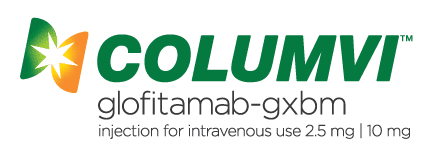July 2023:
The Food and Drug Administration gave accelerated approval to glofitamab-gxbm (Columvi, Genentech, Inc.) for relapsed or refractory diffuse large B-cell lymphoma, not otherwise specified (DLBCL, NOS) or large B-cell lymphoma (LBCL) arising from follicular lymphoma, after two or more lines of systemic therapy.
Glofitamab-gxbm, which is a bispecific CD20-directed CD3 T-cell engager, was studied in study NP30179 (NCT03075696), which was an open-label, single-arm, multicenter trial with 132 patients to test its effectiveness. Eighty percent of the patients had DLBCL, NOS that had come back or didn’t respond to treatment, and 20% had LBCL that came from follicular lymphoma. At least two lines of systemic treatment had been used before (median 3, range 2–7). Patients with current or past diseases or lymphomas of the central nervous system were not allowed to take part in the trial.
Using the 2014 Lugano standards, an Independent Review Committee looked at the objective response rate (ORR) and duration of response (DOR) to figure out how well the treatment worked. The ORR was 56% (95% CI: 47–65), and 43% of people gave full answers. Respondents were followed up on for an average of 11.6 months, so the median DOR was predicted to be 18.4 months (95% CI: 11.4, not estimable). Kaplan-Meier’s estimate for DOR after 9 months was 68.5% (95% CI: 56.7, 80.3). The average amount of time to hear back was 42 days.
There is a Boxed Warning about cytokine release syndrome (CRS), which can be very dangerous or even kill you. Other Warnings and Precautions include neurotoxicity, such as Immune Effector Cell-Associated Neurotoxicity (ICANS), major infections, and tumour flare. When the safety of 145 people with relapsed or refractory LBCL was looked at, 70% had CRS (Grade 3 or higher CRS, 4.1%), 4.8% had ICANS, 16% had major infections, and 12% had their tumours get worse.
Aside from lab words, the most common side effects were CRS, pain in the muscles and joints, rashes, and tiredness. Most Grade 3 to 4 lab findings (about 20%) were drops in lymphocyte counts, phosphate, neutrophil counts, and fibrinogen, and rises in uric acid.
After a single 1,000 mg dose of obinutuzumab on Day 1 of Cycle 1 to deplete circulating and lymphoid tissue B cells, glofitamab-gxbm is given by intravenous infusion according to a step-up dosing schedule: 2.5 mg on Day 8 of Cycle 1 and 10 mg on Day 15 of Cycle 1, then 30 mg on Day 1 of each subsequent cycle for a maximum of 12 cycles. The length of the cycle is 21 days. For full dose information, look at the information that comes with the prescription.
Glofitamab-gxbm should only be given by a medical worker who has the right tools to handle severe reactions, such as CRS. Because of the risk of CRS, patients should stay in the hospital during and for 24 hours after the first step-up dose (2.5 mg on Day 8 of Cycle 1) and for the second step-up dose (10 mg on Day 15 of Cycle 1) if any grade CRS happens with the 2.5 mg dose. Patients who had CRS of Grade 2 or higher with their last infusion should stay in the hospital during the next infusion and for 24 hours after it is done.
The FDA Oncology Centre of Excellence set up Project Orbis, which was used to do this study. Project Orbis gives foreign partners a way to submit and review oncology drugs at the same time. For this review, the FDA worked with Swissmedic, which is where the application is being looked at.
View full prescribing information for Columvi.


